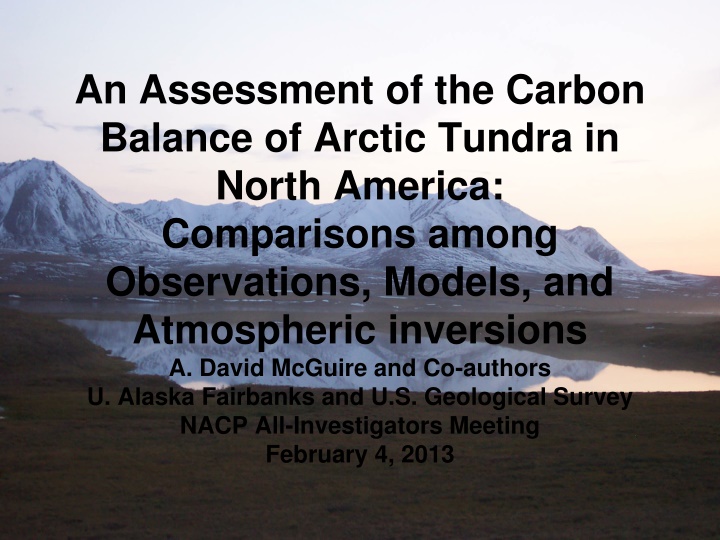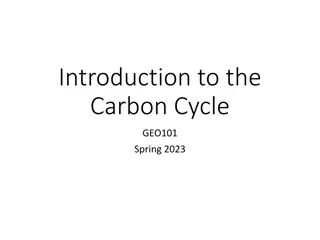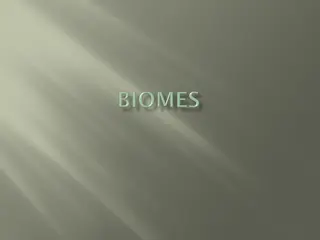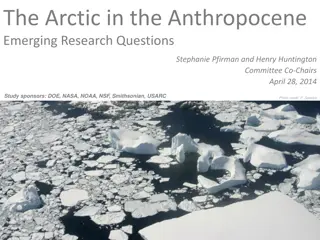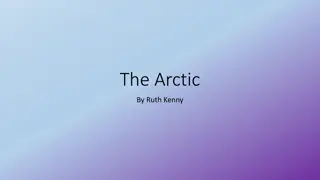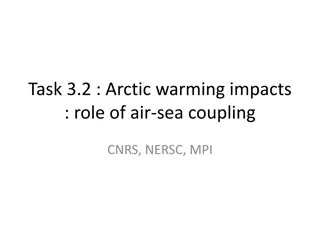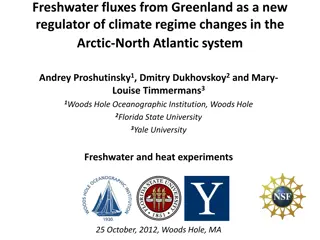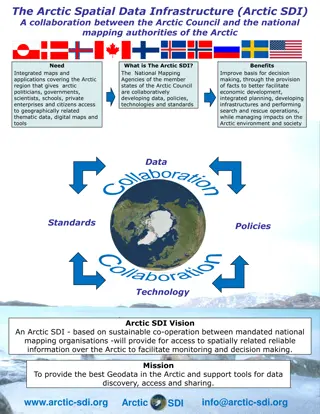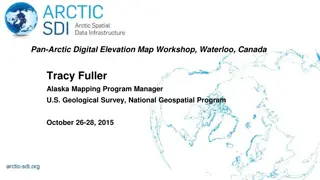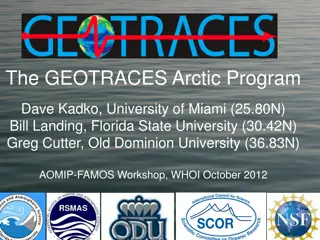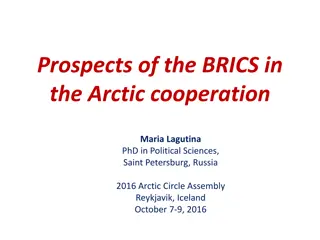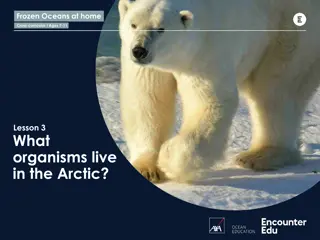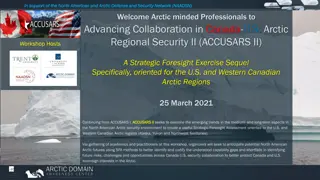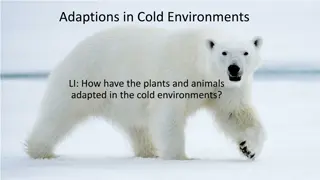Carbon Balance of Arctic Tundra in North America: An Overview
This assessment delves into the carbon balance of Arctic tundra in North America, comparing observations, models, and atmospheric inversions. Co-authored by researchers from various institutions, the study analyzes data from 1960 onwards, addressing the changing CO2 sink in high latitudes. It evaluates the cumulative net ecosystem exchange (NEE) since 1960 and synthesizes tundra observations on CO2 and CH4 exchange from multiple studies. The analysis reveals challenges in distinguishing annual CO2 exchange in tundra regions, highlighting the complexity of the carbon balance in this unique ecosystem.
Download Presentation

Please find below an Image/Link to download the presentation.
The content on the website is provided AS IS for your information and personal use only. It may not be sold, licensed, or shared on other websites without obtaining consent from the author.If you encounter any issues during the download, it is possible that the publisher has removed the file from their server.
You are allowed to download the files provided on this website for personal or commercial use, subject to the condition that they are used lawfully. All files are the property of their respective owners.
The content on the website is provided AS IS for your information and personal use only. It may not be sold, licensed, or shared on other websites without obtaining consent from the author.
E N D
Presentation Transcript
An Assessment of the Carbon Balance of Arctic Tundra in North America: Comparisons among Observations, Models, and Atmospheric inversions A. David McGuire and Co-authors U. Alaska Fairbanks and U.S. Geological Survey NACP All-Investigators Meeting February 4, 2013
Co-authors: T.R. Christensen Lund University, Sweden Dan Hayes Oak Ridge National Laboratory, USA Arnaud Heroult Lund University, Sweden Eugenie Euskirchen University of Alaska Fairbanks, USA John Kimball University of Montana, USA Charles Koven Lawrence Berkeley National Lab, USA Peter Lafleur Trent University, Canada Paul Miller Lund University, Sweden Walt Oechel San Diego State University, USA Philippe Peylin LSCE, France Mathew Williams University of Edinburgh, UK Yonghong Yi University of Montana, USA
Is the CO2 sink of N. High Latitudes Changing? 0.5 SOURCE 0.0 (1) BONA -0.5 Cumulative NEE since 1960 (Pg C) -1.0 BOEU -1.5 SINK -2.0 -2.5 -3.0 BOAS -3.5 -4.0 -4.5 -5.0 (2) -5.5 -6.0 1960 1965 1970 1975 1980 1985 1990 1995 2000 2005 Year From Hayes et al. (2011, Global Biogeochemical Cycles)
Arctic Tundra Domain as defined by the Regional Carbon Cycle Assessment and Processes (RECCAP) Synthesis Activity McGuire et al. 2012. An assessment of the carbon balance of arctic tundra: Comparisons among observations, process models, and atmospheric inversions. Biogeosciences 9: 3185-3204, doi:10.5194/bg-9-3185-2012.
Analysis of Observations (1990 2009) Includes both chamber-based and tower-based studies ~225 estimates of CO2 exchange tundra-wide ~110 North America CO2 exchange estimates for tundra ~152 estimates of CH4 exchange tundra-wide ~45 North America CH4 exchange estimates for tundra
Synthesis of Tundra Observations Annual exchange of CO2 cannot be distinguished from neutral balance across the range of studies that have been conducted
Summary of Observationally Based Estimates of Mean Net CO2-C and CH4-C Exchange from Arctic Tundra to the Atmosphere (g C m-2 season-1) for Different Subregions Time Period North America North Atlantic Northern Europe Eurasia CO2 Exchange Summer Before 2000 -7 (521; -22 to 72) -32 (9; -58 to -5) -98 (4; -127 to -68) -25 (18; -50 to -1) Since 2000 -18 (28; -39 to 3) -53 (12; -90 to 16) -92 (5; -220 to 36) -73 (12; -141 to -4) Annual Before 2000 29 (9; 2 to 57) - -25 (6; -63 to -14) - Since 2000 -3 (14; -28 to 21) - -19 (33; -30 to -8) - CH4 Exchange Summer Before 2000 2.4 (10; 0.7 to 4.2) - 7.8 (13; 1.4 to 14.2) 3.0 (15; -0.4 to 6.5) Since 2000 1.4 (9; -0.2 to 2.9) - 12.5 (10; 1.9 to 23.0) 5.1 (29; 1.6 to 8.6) Annual Before 2000 4.4 (24; 1.4 to 7.4) - 15.0 (3; -18.3 to 48.3) - Since 2000 16.9 (2; -12.0 to 45.7) - 11.3 (27; 6.6 to 16.0) 8.2 (7; -1.8 to 18.1) 1Number of site-year estimates 295% confidence interval
Summary of Observationally Based Estimates of Mean Net CO2-C and CH4-C Exchange from Arctic Tundra to the Atmosphere (g C m-2 season-1) for Different Tundra Types Time Period Wet Tundra Dry/Mesic Tundra CO2 Exchange Summer -43 (451; -27 to -592) 5 (46; -11 to 21) Winter 31 (3; 1 to 61) 31 (7; 11 to 51) Annual -26 (27; -15 to -37) 10 (12; -27 to 47) CH4 Exchange Summer 9.2 (38; 5.4 to 13.0) 0.8 (25; 0.3 to 1.4) Annual 14.6 (22; 8.5 to 20.2) 2.3 (24; 0.3 to 4.3) 1Number of site-year estimates 295% confidence interval
Process-based Modeling Regional Applications of Models: - TEM6 Permafrost, Vertical SOM, CH4, Fire - LPJ-Guess WHyMe Permafrost, CH4, Fire - Orchidee with Cryoturbation - Terrestrial Carbon Flux (TCF) Diagnostic Model Global Applications of Trendy DGVMs: CLM4C, CLM4CN, Hyland, LPJ, LPJ-Guess, Orchidee N, SDGVM, Triffid Compared two decades: 1990 1999 and 2000 - 2006 Spatial domain defined by RECCAP Arctic Tundra mask
Mean NEE of Arctic Tundra Simulated by Process Models Model g C m-2 yr-1 (negative = sink) Regional Apps. LPJ-G WHyMe Orchidee TEM6 1990-1999 2000-2006 -21 (-241) -28 -6 (-11) -24 (-251) -34 -3 (31) - Global Apps. CLM4C CLM4CN Hyland LPJ LPJ-Guess Orchidee N SDGVM TRIFFID 0 -1 0 -20 -21 -1 -18 -8 -1 -1 0 -3 -24 -3 -16 -17 NEE ranged between 0 and 34 g C m-2 yr-1 sink; sink increases between decades 1 Results for North America
Changes in the Seasonal Cycle of NEP Estimated by the Regional Process Models In the 2000s, LPJ-Guess WHyMe and Orchidee estimate greater uptake in early and mid-growing season, while TEM6 estimates greater uptake in the late growing season; lower NEP in October driven by greater RH during the 2000s in all models.
Atmospheric Inversion Modeling 10 models 1985 2009 depending on model Spatial domain defined by RECCAP Arctic Tundra mask
Mean NEE of Arctic Tundra Estimated by Inversion Models Model gC m-2 yr-1 (negative = sink) 1990-1999 2000-2006 C13_CCAM_law - 26 C13_MATCH_rayner - -31 JENA_s96_v3.3 - -13 JMA_2010 -35 -37 LSCE_an_v2.1 - -14 LSCE_var_v1.0 15 22 NICAM_niwa_woaia -19 -9 rigc_Patra - -48 NEE ranged between 26 g C m-2 yr-1 source and 48 g C m-2 yr-1 sink Sink increases between decades
Interannual Variability of Carbon Fluxes from Inversions Interannual anomalies vary from 2.1 to 13.1 g C m-2 yr-1 (standard deviation) Correlation of interannual anomalies is poor (mean r=0.03, range: -0.38 to 0.99)
Comparison of Regional NEE among Methods (Tg C yr-1) Regional Process- Based Models 1990 - 1999 Central Estimate N. AMERICA 126 1990 -1999 Uncertainty N. AMERICA 8 to 243 -102 to -4 2000 - 2006 Central Estimate N. AMERICA -14 2000 2006 Uncertainty N. AMERICA -118 to 90 -107 to 13 Global Process- Based Models Inversion Models Time Period Observations -78 - 138 -166 -53 -13 - -102 to 378 -255 to -55 -188 to 0 - -321 to 140 - -93 - -202 -187 -47 -117 - -628 to 224 -312 to -28 -222 to -1 - -439 to 243 - Observations and Inversions Can t be distinguished from neutral balance Process-Model Simulations Arctic tundra has been a sink in the 1990s and 2000s Only one central estimate is a source (observations in 1990s North America) All methods indicate that Arctic tundra has become a stronger sink in the 2000s
Comparison of Regional CH4 among Methods (Tg C yr-1) Regional Process- Based Models 1990 - 1999 Central Estimate N. AMERICA 3 1990 -1999 Uncertainty N. AMERICA 1 to 6 1 to 3 2000 - 2006 Central Estimate N. AMERICA 13 2000 2006 Uncertainty N. AMERICA -10 to 35 1 to 3 Global Process- Based Models Inversion Models Time Period Observations 10 25 2 - - - - -1 to 22 15 to 34 - - - - 20 28 2 - - - - -11 to 51 18 to 37 - - Process-Model Simulations tundra emissions are higher than observed estimates, but not for North America. Substantial overlap in uncertainties between observations and model estimates. Both methods suggest that methane emissions increased from 1990s to 2000s.
Arctic Tundra C Assessment Conclusions Estimates of NEE based on observations and inversions have large uncertainties that cannot be distinguished from neutral balance, except for observations of tundra in North America in 1990s. Process models generally indicate that Arctic tundra acted as a sink for CO2 in recent decades. Central estimates based on observations, process-models, and inversions each suggest stronger sinks for CO2 (except central estimates of process-models for North America) and stronger sources of CH4 in the 2000s vs. 1990s. There is a need to reduce uncertainties from observations by better stratification of observations between wet and dry/mesic tundra. Simulation of the difference between production and decomposition is important to improve in models for assessing responses of Arctic tundra to projected climate change.
